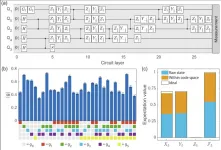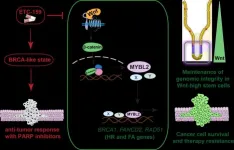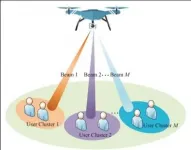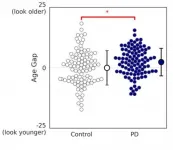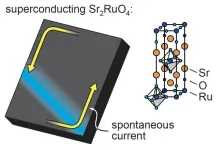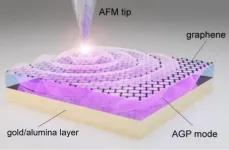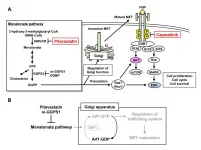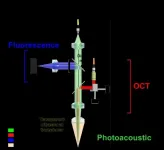(Press-News.org) Universal fault-tolerant quantum computing relies on the implementation of quantum error correction. An essential milestone is the achievement of error-corrected logical qubits that genuinely benefit from error correction, outperforming simple physical qubits. Although tremendous efforts have been devoted to demonstrate quantum error correcting codes with different quantum hardware, previous realizations are limited to be against certain types of errors or to prepare special logical states. It remains one of the greatest and also notoriously difficult challenges to realize a universal quantum error correcting code for more than a decade.
In a new research article published in the Beijing-based National Science Review, scientists at the University of Science and Technology of China, the Tsinghua University, and at the University of Oxford, present their latest work on experimental exploration of five-qubit quantum error correcting code with superconducting qubits. The authors realized the [[5,1,3]] code on a superconducting quantum processor, verified the viability of experimental realization of quantum error correcting codes with superconducting qubits.
These scientists completed the important step towards the implementation of quantum error correction. This is achieved first by dedicated experimental optimization of superconducting quantum qubits, enabling the realization of more than a hundred quantum gates. Focusing on the five-qubit quantum error correcting code, the so-called 'perfect code' that corrects single generic qubit errors, they theoretically compiled and optimized its encoding process to have the minimal possible number (eight) of nearest-neighbor controlled-phase gates. These experimental and theoretical advances finally enabled the realization of the basic ingredients of a fully functional five-qubit error correcting code, involving the encoding of a general logical qubit into an error correcting code, with the subsequent verification of all key features including the identification of an arbitrary physical error, the power for transversal manipulation of the logical state, and state decoding.
"The device for the implementation of the five-qubit error correcting code is a 12-qubit superconducting quantum processor. Among these 12 qubits, we chose five adjacent qubits to perform the experiment. The qubits are capacitively coupled to their nearest neighbours. The capacitively coupled XY control lines enable the application of single-qubit rotation gates by applying microwave pulses, and the inductively coupled Z control lines enable the double-qubit controlled-phase gates by adiabatically tune the two-qubit state |11> close to the avoid level crossing of |11> and |02>. After careful calibrations and gate optimizations, we have the average gate fidelities as high as 0.9993 for single-qubit gates and 0.986 for two-qubit gates. With the implementation of only single-qubit rotation gates and double-qubit controlled-phase gates, we realized the circuit for encoding and decoding of the logical state." they state in an article titled "Experimental exploration of five-qubit quantum error correcting code with superconducting qubits."
"On a superconducting quantum processor, we experimentally realised the logical states |0>_L, |1>_L, |±>_L, and |±i>_L that are eigenstates of the logical Pauli operators X_L, Y_L, and Z_L, and the magic state |T>_L= (|0>_L+e^{i\pi/4}|1>_L)/\sqrt{2} that cannot be realized by applying Clifford operations on any eigenstate of the logical Pauli operators," they add. "Finally, the state fidelity of |T>_L reaches 54.5(4)%."
"The quality of the prepared logical states can also be divided into its overlap with the logical code space and its agreement with the target logical state after projecting it into the code space," they stated. After projecting to the code space, the average value is as high as 98.6(1)%. "Since projecting to the code space is equivalent to post-selecting all +1 stabilizer measurements, our result also indicates the possibility of high fidelity logical state preparation with future non-destructive stabilizer measurements."
After the realisation of logical state, the scientists proceed with the verification of error correction/detection ability of the five qubit code. "As shown in Fig.2(a) we do indeed find, for each case, the corresponding syndrome pattern that identifies the location of the single-qubit error," they added.
Then, the scientists implemented and verified the transversal logical operations, and performed the quantum process tomography within the code space to characterize these logical operations. "We determine gate fidelities of the logical X_L, Y_L, and Z_L operations to be 97.2(2)%, 97.8(2)%, and 97.3(2)%, respectively," they stated.
"Finally, after encoding the single-qubit input state into the logical state, we apply the decoding circuit, see Fig. 4(a), to map it back to the input state," they added. "After quantum process tomography from the four output states, the process fidelity is determined as 74.5(6)% as shown in Fig. 4(b)."
"An essential milestone on the road to fault-tolerant quantum computing is the achievement of error-corrected logical qubits that genuinely benefit from error correction, outperforming simple physical qubits," they add. "Direction for future works include the realization of non-destructive error detection and error correction, and the implementation of logical operations on multiple logical qubits for the five-qubit code. Our work also has applications in error mitigation for near-term quantum computing."
INFORMATION:
This work was supported by the National Key Research and Development Program of China (2017YFA0304300, 2017YFA0303900 and 2017YFA0304004), the National Natural Science Foundation of China (11875173, 11674193, 11574380 and 11905217), the Chinese Academy of Science, Science and Technology Committee of Shanghai Municipality (16DZ2260100), Anhui Initiative in Quantum Information Technologies, and Engineering and Physical Sciences Research Council (EP/M013243/1 to S.C.B and X.Y.).
See the article:
Ming Gong, Xiao Yuan, Shiyu Wang, Yulin Wu, Youwei Zhao, Chen Zha, Shaowei Li, Zhen Zhang, Qi Zhao, Yunchao Liu, Futian Liang, Jin Lin, Yu Xu, Hui Deng, Hao Rong, He Lu, Simon C Benjamin, Cheng-Zhi Peng, Xiongfeng Ma, Yu-Ao Chen, Xiaobo Zhu, Jian-Wei Pan
Experimental exploration of five-qubit quantum error correcting code with superconducting qubits
Natl Sci Rev, nwab011, (2021)
https://doi.org/10.1093/nsr/nwab011
SINGAPORE, 16 March 2021 - ETC-159, a made-in-Singapore anti-cancer drug that is currently in early phase clinical trials for use in a subset of colorectal and gynaecological cancers, could also prevent some tumours from resisting therapies by blocking a key DNA repair mechanism, researchers from Duke-NUS Medical School and the Agency for Science, Technology and Research (A*STAR) in Singapore reported in the journal EMBO Molecular Medicine.
Among the many therapies used to treat cancers, inhibitors of the enzyme poly (ADP ribose) polymerase (PARP) prevent cancer cells from repairing naturally occurring DNA damage, including unwanted/harmful breaks in the DNA. When too many breaks accumulate, the cell dies.
"Some cancers have an overactive Wnt signalling pathway that may make them ...
Non-orthogonal multiple access (NOMA) and millimeter-wave (mmWave) are two crucial techniques of 5G to meet the explosive capacity demands. On the other hand, UAVs deployed as aerial base stations are potential to provide ubiquitous coverage and satisfy users' multifarious requirements due to their flexibility and mobility. Nevertheless, the finite onboard energy is a fundamental limit of UAVs, which can deter the performance of UAV communication networks. Therefore, the researchers Xiaowei PANG and Nan ZHAO from Dalian University of Technology, Jie TANG and Xiuyin ZHANG from South China University of Technology, and Yi QIAN from University of Nebraska-Lincoln have focused on designing energy-efficient ...
SAN ANTONIO -- March 16, 2021 -- One of the most profound discoveries in planetary science over the past 25 years is that worlds with oceans beneath layers of rock and ice are common in our solar system. Such worlds include the icy satellites of the giant planets, like Europa, Titan and Enceladus, and distant planets like Pluto.
In a report presented at the 52nd annual Lunar and Planetary Science Conference (LPSC 52) this week, Southwest Research Institute planetary scientist S. Alan Stern writes that the prevalence of interior water ocean worlds (IWOWs) in our solar system suggests they may be prevalent in other star systems as well, vastly expanding the conditions for planetary habitability and biological survival over time.
It has been known for many years that worlds like Earth, ...
Parkinson's disease (PD) is a well-studied neurodegenerative disorder that affects between 7 and 10 million people worldwide. Despite PD being a recurrent topic in the medical literature for over 200 years, its mechanisms are largely unclear, and existing treatments are aimed at improving the patient's symptoms.
Among PD's most common symptoms are motor problems, including as tremors, slowness, and muscular rigidity. These, combined with many non-motor symptoms, cause many PD patients to develop facial abnormalities, such as face skin problems and difficulties making facial expressions. Such problems are not to be taken lightly, as one's face plays a crucial ...
Superconductivity is a complete loss of electrical resistance. Superconductors are not merely very good metals: it is a fundamentally different electronic state. In normal metals, electrons move individually, and they collide with defects and vibrations in the lattice. In superconductors, electrons are bound together by an attractive force, which allows them to move together in a correlated way and avoid defects.
In a very small number of known superconductors, the onset of superconductivity causes spontaneous electrical currents to flow. These currents ...
KAIST researchers and their collaborators at home and abroad have successfully demonstrated a new methodology for direct near-field optical imaging of acoustic graphene plasmon fields. This strategy will provide a breakthrough for the practical applications of acoustic graphene plasmon platforms in next-generation, high-performance, graphene-based optoelectronic devices with enhanced light-matter interactions and lower propagation loss.
It was recently demonstrated that 'graphene plasmons' - collective oscillations of free electrons in graphene coupled to electromagnetic waves of light - can be used to trap and compress optical waves inside a very thin dielectric ...
An analysis has found deforestation is severely affecting forest bird species in Colombia, home to the greatest number of bird species in the world.
University of Queensland-led research, steered by Dr Pablo Negret, analysed the impact of deforestation on 550 bird species, including 69 only found in the South American nation.
"Our study has shown an astonishing reduction in bird species habitat," Dr Negret said.
"One third of the forest bird species in Colombia have lost at least a third of their historical habitat, and that's just using the most recent data we have available - from 2015.
"Moreover, 18 per cent or 99 species have lost more than half of their historical habitat to date.
"By 2040, we expect this will increase to 38 per cent or 209 species.
"Sadly, many of those ...
A team of scientists led by Nanyang Technological University, Singapore (NTU Singapore) has developed a device that can deliver electrical signals to and from plants, opening the door to new technologies that make use of plants.
The NTU team developed their plant 'communication' device by attaching a conformable electrode (a piece of conductive material) on the surface of a Venus flytrap plant using a soft and sticky adhesive known as hydrogel. With the electrode attached to the surface of the flytrap, researchers can achieve two things: pick up electrical signals to monitor how the plant responds to ...
Researchers from Tokyo Medical and Dental University (TMDU) uncover potential novel therapeutic strategies for oral and esophageal carcinomas
Tokyo, Japan - Discovering and treating tumors before they spread throughout the body is key for cancer patients to achieve positive outcomes. When tumor cells spread, which is known as metastasis, they can take over other organs and lead to death. Oral and esophageal carcinomas, or mouth and throat cancers, frequently metastasize to the lymph nodes. Unfortunately, there are currently no therapies that are specific to treating these particular cancers. Now, researchers at Tokyo Medical and Dental University (TMDU) identified several drugs ...
A quadruple fusion optical and ultrasound imaging system has been developed that allows diagnosis of eye conditions or tumors or to see the environment inside the body using a transparent ultrasound transducer.
Professor Chulhong Kim of POSTECH's Department of Electrical Engineering, Convergence IT Engineering, and Mechanical Engineering, Dr. Byullee Park of Department of Convergence IT Engineering, Ph.D. candidate Jeongwoo Park of School of Interdisciplinary Bioscience and Bioengineering, Professor Hyung Ham Kim of Department of Convergence IT Engineering, and Professor Unyong Jeong of Department of Materials ...
